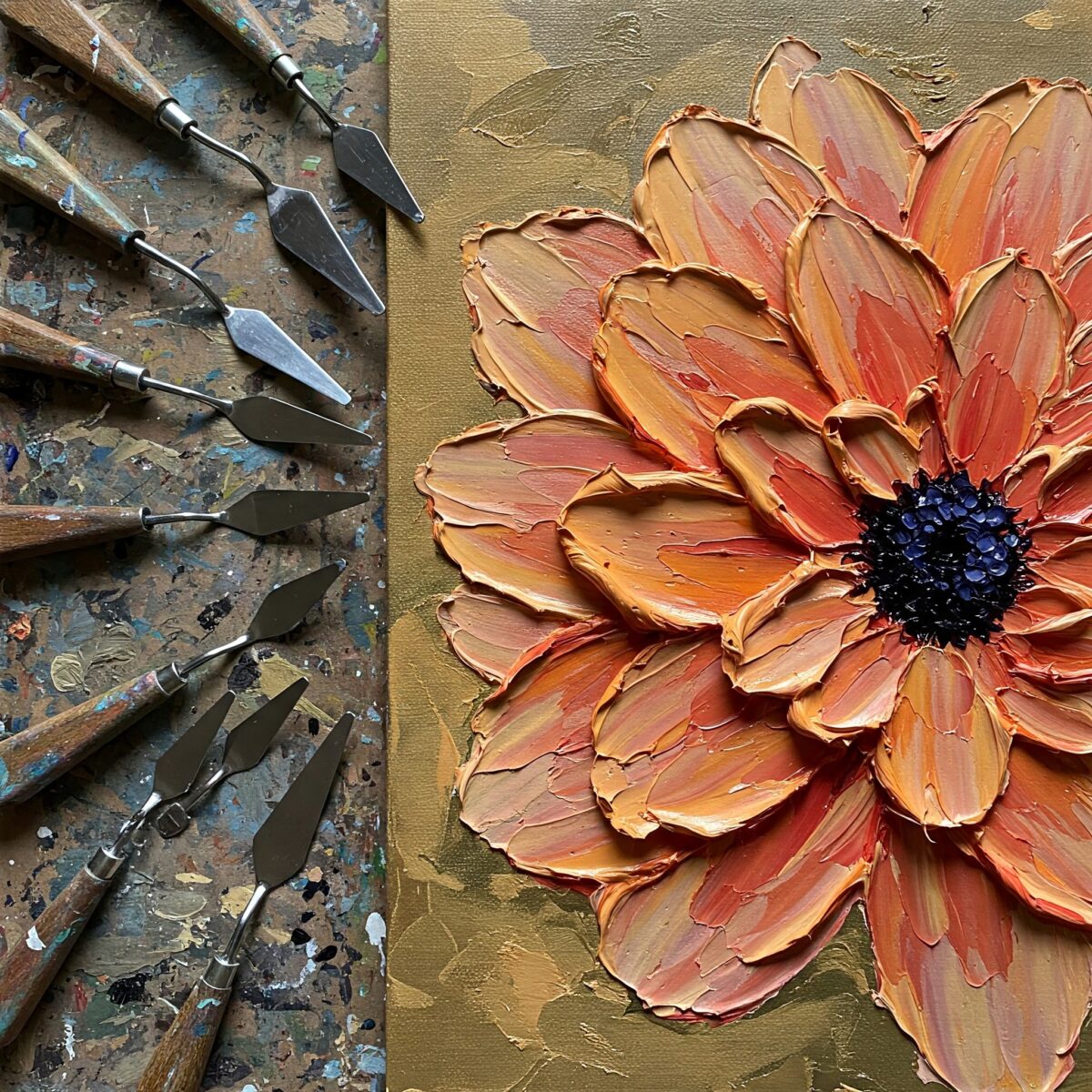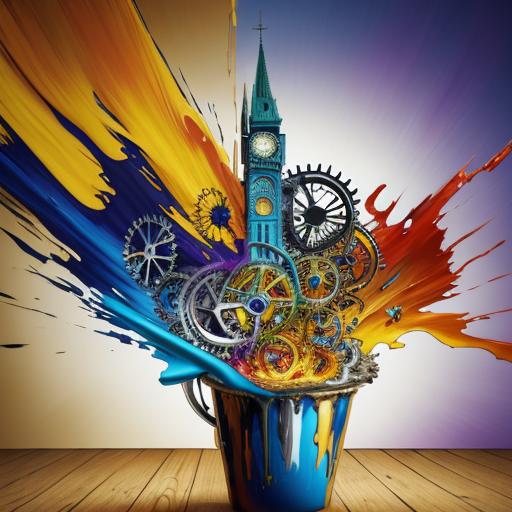Exploring flower painting techniques opens a colorful world where art meets nature. Whether you’re a beginner picking up a brush for the first time or an experienced artist looking to improve your floral artwork, mastering various approaches to painting petals, stems, and blooms can transform your artistic journey. From the vibrant possibilities of acrylics to the delicate transparency of watercolors and the rich textures of oils, each medium offers unique ways to capture the beauty of flowers on canvas. This comprehensive guide will walk you through essential techniques, brush methods, and medium-specific approaches that will help you create stunning flower art that blooms with life and dimension.
Key Points:
- Different painting mediums (watercolor, acrylic, oil) offer unique advantages for flower painting
- Mastering basic brush techniques is essential for creating realistic flower petals
- Simple flowers like daisies provide perfect starting points for beginners
- Complex blooms like roses require specific approaches to capture their structure
- Developing your own style comes through practice, experimentation, and combining techniques
- Listen to our Podcast on Flower Painting Techniques
- Acrylic Techniques for Floral Art
- Watercolor Approaches to Flower Art
- Oil Painting Methods for Floral Subjects
- One-Stroke Flower Petal Techniques
- Specialized Brush Holds and Applications
- Roses and Complex Blooms
- Daisies and Simple Petal Structures
- Tropical and Distinctive Flowers
- Table of Famous Painters known for their Flower Paintings
- Practice Exercises for Beginners
- Experimental Approaches and Personal Style
- What are the best brushes for painting flowers?
- How do I mix colors for realistic flowers?
- Where can I find good flower painting reference photos?
- What techniques did famous flower painters use?
- What's the easiest way to paint different types of flowers for beginners?
Listen to our Podcast on Flower Painting Techniques
Choosing the Right Medium for Flower Painting Techniques
The medium you select dramatically impacts how your floral artwork will look and feel. Each paint type brings distinct qualities that can enhance different aspects of flower painting.
Acrylic Techniques for Floral Art
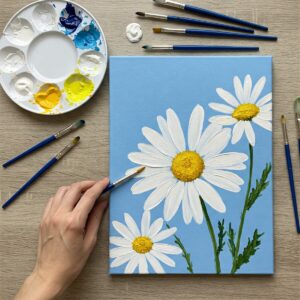
Acrylics offer remarkable versatility for flower painters. Their quick-drying nature makes them perfect for building layers quickly, while their opacity creates vibrant, bold flower colors that pop against backgrounds.
One fundamental technique in acrylic flower painting is wet-on-wet canvas blending. By applying paint and blending while still wet, you can create smooth transitions between colors – perfect for the gentle color shifts in rose petals or the gradient effects in sunflowers.
For beginners, the one or two-stroke method simplifies complex flowers by using just a couple of brush movements to create each petal. This approach focuses on capturing the basic form rather than getting lost in tiny details.
Texture development is another strength of acrylic flower painting. Try these approaches:
- Use palette knives to create textured effects for flower centers
- Blend paint with paper towels to create softer textures for foliage
- Build layers to add depth and dimension to your floral compositions
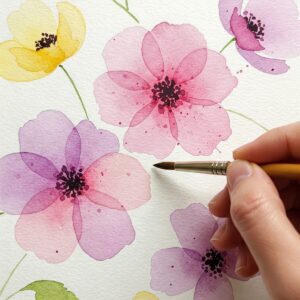
Watercolor Approaches to Flower Art
Watercolor creates a distinctly different effect in flower painting, characterized by transparency and fluidity that many artists find perfectly suited to floral subjects. The delicate, graceful qualities of watercolor often complement the natural characteristics of flowers, creating harmonious representations.
Basic watercolor flower techniques involve understanding water control:
- More water creates soft, diffused edges (wet-on-wet technique)
- Less water produces more defined shapes (wet-on-dry technique)
- Varying water content creates depth and dimension in petals
“Watercolor shares qualities with flowers—being delicate, dainty, graceful and full of life—making it an ideal medium for floral subjects.”
Siân Dudley, watercolor artist
A common mistake in watercolor flower painting is failing to vary water content appropriately, which can lead to muddy colors or lack of depth. Mastering the balance of water to pigment ratio is essential for creating luminous, vibrant flower paintings.
For beginners, starting with simple flowers like daisies before progressing to more complex blooms allows for gradual skill development while building confidence with the watercolor medium.
Oil Painting Methods for Floral Subjects
Oil paints offer unique properties that create distinctive floral artwork. Unlike the quick-drying nature of acrylics or the fluidity of watercolors, oils possess a thickness and permanence that allows for rich, luminous color and beautiful texture.
The slower drying time of oils allows for extended blending periods, creating incredibly smooth transitions between colors on petals. Artists can work wet-into-wet for several days, adjusting and refining their floral compositions in ways impossible with faster-drying mediums.
Texture techniques particularly shine in oil flower painting:
- Use palette knives for impasto effects that create dimensional petals
- Apply brushes for smoother blending across petals
- Try unconventional tools like toothbrushes to flick paint for fine textures
Water-mixable oils provide an accessible entry point for artists concerned about traditional oil painting cleanup and toxicity. These modified oils maintain many of the desirable properties of traditional oils while allowing for easier cleanup with water rather than solvents.
Essential Brush Techniques for Flower Painting
The way you handle your brush dramatically affects how your flowers will look. Mastering a few key brush techniques will elevate your flower painting immediately.
One-Stroke Flower Petal Techniques
The one-stroke painting technique is one of the most efficient and effective methods for creating flower petals. This approach involves loading a brush with multiple colors simultaneously (often called “double-loading”) and then creating a petal shape with a single stroke.
Different petal shapes require different approaches:
- For jagged-edge petals: Start on the chisel edge of a flat brush, lean toward the flat side, and use quick zigzagging motions
- For teardrop petals: Start on the chisel edge, press down to bend the bristles, pivot the colored edge, then lift back to create a pointed tip
- For ruffled petals: Begin at the petal base with a double-loaded flat brush, push down while wiggling the brush upward, then smooth toward the tip
These specialized strokes create natural color variation and highlights within each petal while maintaining efficiency in the painting process.
Specialized Brush Holds and Applications

Mastering various brush holds fundamentally transforms how you can render flowers, with each position offering unique capabilities for different floral elements.
The manipulation of brush pressure plays a crucial role in creating dimensional flower elements. By varying pressure throughout a stroke, you create natural tapering effects essential for realistic petals. Start with light pressure at a petal base, increase pressure at the middle, and lift to return to light pressure at the tip.
Artists develop specialized applications for standard brushes:
- Use the tip of a round brush for stamens and pistils
- Apply the side of a brush for soft petal edges
- Try controlled dry brush techniques for texture
- “Scruff” with partially dry brushes to create textured centers for flowers like sunflowers
Visit ProminentPainting’s guide to brush selection to learn more about choosing the right tools for your flower paintings.
Painting Specific Flower Types
Different flowers require different approaches due to their unique structures and characteristics.
Roses and Complex Blooms
Roses present particular challenges due to their complex structure with overlapping petals and subtle color gradations. While traditionally considered difficult subjects, simplified approaches make rose painting accessible even to beginners.
Instead of attempting to render every petal realistically, try these approaches:
- Create basic rose shapes through circular brushstrokes that suggest the spiral formation of petals
- Focus on the overall form rather than individual details
- Pay attention to light and shadow patterns that give roses dimension
Color blending plays a crucial role in successful rose painting. Each medium requires a different approach:
- Acrylic painters: Use wet-on-wet techniques to blend colors directly on the canvas
- Oil painters: Leverage the slow drying time to achieve extremely subtle blending
- Watercolorists: Build translucent layers, allowing each to dry partially before adding the next
Daisies and Simple Petal Structures
Daisies and other simple-structured flowers provide excellent starting points for beginning flower painters due to their straightforward petal arrangements and clear forms.
Basic techniques for painting daisies often involve:
- Creating a circle for the center
- Adding evenly spaced petals radiating outward
- Using a flat brush to create each petal with a single stroke
- Adding a touch of blue or other color to the petal centers for subtle shading
Compositional approaches for simple flowers create visual interest:
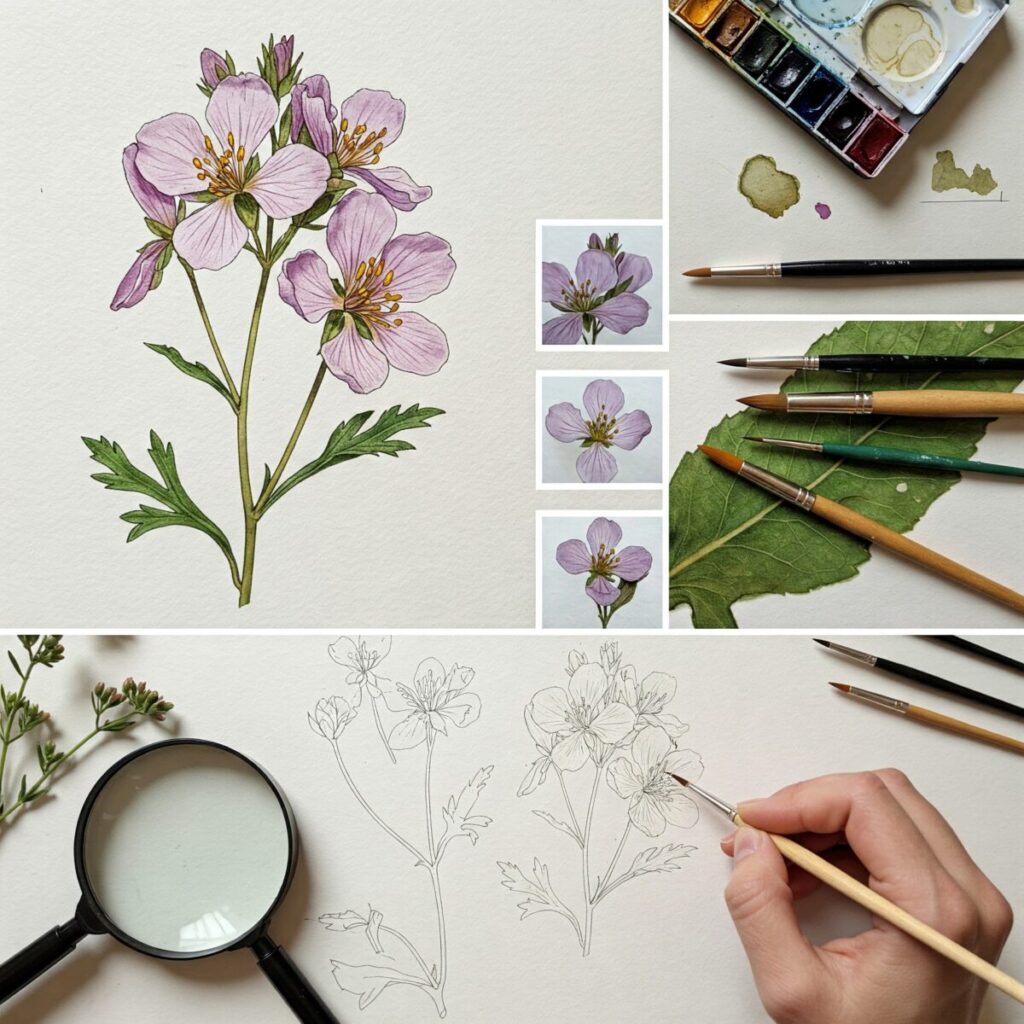
- Paint daisies in clustered groupings, varying sizes and viewing angles
- Place flowers in containers like mason jars or vases to explore transparency and reflection
- Create fields of wildflowers with varied heights and densities
Learn more about painting simple flowers with this helpful guide to wildflower painting techniques from ProminentPainting.com.
Tropical and Distinctive Flowers
Tropical flowers with their bold forms and vibrant colors present unique painting opportunities. Flowers like hibiscus and bird of paradise feature distinctive shapes that require specialized approaches.
Color intensity represents a defining characteristic of tropical flower painting. Techniques for balancing intensity with harmony include:
- Using complementary colors in backgrounds to enhance flower colors
- Employing strategic neutrals to provide visual rest
- Understanding how to modulate saturation throughout the composition
Consider scale and proportion when painting distinctive flowers. Try these approaches:
- Create compositions where a single dramatic flower fills the entire canvas
- Crop compositions to show only a portion of a distinctive flower
- Emphasize pattern and color over literal representation
Table of Famous Painters known for their Flower Paintings
| Painter | Nationality | Period | Notable Works |
|---|---|---|---|
| Jan Davidsz de Heem | Dutch | 17th Century | Realistic floral still lifes. |
| Georgia O’Keeffe | American | 20th Century | Large-scale flower paintings, e.g., Jimson Weed/White Flower No. 1. |
| Vincent van Gogh | Dutch | Late 19th Century | Sunflowers, Irises, and Roses. |
| Claude Monet | French | Late 19th to Early 20th Century | Water Lilies series. |
| Maria van Oosterwijck | Dutch | 17th Century | Delicate flower paintings with insects and other objects. |
| Ambrosius Bosschaert the Elder | Dutch | Early 17th Century | Still-Life with Flowers. |
| Rachel Ruysch | Dutch | Late 17th to Early 18th Century | Asymmetrical flower compositions. |
| Pierre-Joseph Redouté | French | Late 18th to Early 19th Century | Royal flower painter, known for roses and lilies. |
| Paul Gauguin | French | Late 19th Century | Flowers and a Bowl of Fruit on a Table. |
| Odilon Redon | French | Late 19th to Early 20th Century | Symbolist flower compositions. |
This table highlights a selection of renowned artists who have contributed significantly to the genre of flower painting across different periods and styles.
Developing Your Flower Painting Skills
Like any art form, flower painting improves with practice and experimentation.
Practice Exercises for Beginners
Structured practice provides the foundation for developing flower painting skills. Effective exercises focus on fundamental techniques before tackling complete compositions.
Try these practice approaches:
- Create “stroke practice sheets” where you repeatedly practice basic shapes like teardrop petals
- Start with simple flowers like daisies before advancing to more complex blooms like roses
- Follow step-by-step tutorials that break complex subjects into manageable stages
- Paint the same flower type multiple times using increasingly complex techniques
These structured learning resources provide essential scaffolding for developing flower painting skills while ensuring successful outcomes that motivate continued practice.
Experimental Approaches and Personal Style
Developing a distinctive approach to flower painting often involves experimenting beyond traditional techniques to discover unique personal methods.
Try these approaches to develop your style:
- Use unconventional tools to create unexpected floral effects
- Mix techniques from different mediums, such as incorporating watercolor approaches into acrylic flower painting
- Experiment with unconventional surfaces that interact with paint in unique ways
- Combine mediums (like watercolor with ink) for flowers that feature both fluid color transitions and precise linear elements
Flower Painting Techniques: Finding Your Blooming Path
The world of flower painting techniques offers endless possibilities for artistic expression. As you explore different mediums, brush techniques, and approaches to specific flower types, you’ll discover which methods resonate most with your artistic sensibilities. Remember that mastering flower painting techniques requires patience and practice, but the journey is as rewarding as the finished pieces. Whether you’re drawn to the luminous transparency of watercolor blooms, the bold vibrancy of acrylic florals, or the rich textures of oil-painted petals, the techniques covered in this guide provide a solid foundation for creating beautiful botanical art that captures the eternal charm of flowers.
FAQ About Flower Painting Techniques
What are the best brushes for painting flowers?
For flower painting, it’s helpful to have a variety of brushes. Round brushes (sizes 2-6) are excellent for details and smaller petals. Flat brushes (1/4″ to 1″) work well for larger petals and broad strokes. Filbert brushes are perfect for creating rounded petal shapes. For fine details like stamens, liner or rigger brushes are ideal. Quality synthetic brushes work well for acrylics and watercolors, while natural hair brushes are often preferred for oils.
How do I mix colors for realistic flowers?
To mix colors for realistic flowers, start with the basic hue of your flower, then add complementary colors to create natural shadows. For example, add a tiny bit of purple to dim a yellow sunflower’s shadow areas. Use white sparingly for highlights. Create depth by mixing slightly different tones for different parts of the same petal. Observe real flowers to note how colors shift across petals—they’re rarely one solid color throughout.
Where can I find good flower painting reference photos?
Good flower reference photos can be found on royalty-free stock photo sites like Unsplash, Pexels, or Pixabay. Botanical gardens often share high-quality images on their websites. Creating your own reference photos gives you control over lighting and composition. Social media platforms like Instagram and Pinterest also offer countless floral photography collections from artists and photographers who specialize in botanical subjects.
What techniques did famous flower painters use?
Georgia O’Keeffe used magnification and cropping to create dramatic flower compositions with smooth color transitions. Claude Monet employed loose brushwork and complementary colors to capture the impression of garden flowers in changing light. Vincent van Gogh applied thick, textured paint with vigorous brushstrokes for emotional flower paintings. Contemporary artist Makoto Fujimura combines traditional Japanese nihonga techniques with abstract expressionism for ethereal floral works.
What’s the easiest way to paint different types of flowers for beginners?
The easiest approach for beginners is to start with simple flower shapes like daisies or poppies that can be created with basic brush strokes. Use a limited palette of 3-5 colors to avoid feeling overwhelmed. Try the one-stroke technique where you load a flat brush with two colors (lighter on one side, darker on the other) to create dimension in a single stroke. Follow step-by-step tutorials that break the process into manageable stages, focusing on general shapes before adding details.

